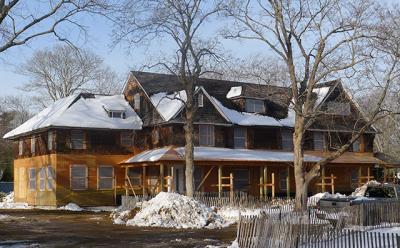Major Medical Issues? Island Gift of Life Is 'Here to Help'
Major Medical Issues? Island Gift of Life Is 'Here to Help'

The Island Gift of Life Foundation helped Janae Jones find her smile.
Four years ago, Ms. Jones was a shy 15-year-old with a very pronounced overbite, one that made her extremely self-conscious and left her vulnerable to teasing at school. She and her mother, Samone Johnson, sought braces and a complicated surgery to fix it. But the surgery would cost several thousand dollars and would not be covered entirely by insurance, so financially it was out of reach for Ms. Johnson, a single mother of four from East Hampton.
Enter Island Gift of Life, a non-profit organization launched in 2001 that helps patients on the East End cope with major medical issues by providing financial support, transportation, or expertise to help negotiate medical bills with hospitals and doctors. It also supports blood and bone marrow registry drives.
“I used to be so shy and so quiet. I didn’t like to smile as much,” said Ms. Jones, now a bubbly 19-year-old student at Suffolk Community College. “The surgery was a confidence booster, definitely.”
Ms. Johnson, who works as a paraprofessional at East Hampton High School and volunteers as an emergency medical technician, raved about the foundation. “For some of the things kids need and parents can’t afford, this organization is always willing to contribute something,” said Ms. Johnson, who said the Kiwanis Club also contributed financially. “This surgery has 100 percent changed my daughter’s life.”
The foundation was conceived by Cheryl Hannabury, a Shelter Island resident who had non-Hodgkins lymphoma. She envisioned an organization that could help patients cope with financial obstacles and other challenges so they could focus on their treatment. Ms. Hannabury died in 2002 after her illness progressed, but the Island Gift of Life Foundation has been able to continue its mission. Today, it has expanded beyond Shelter Island to also help people in the towns of East Hampton, Southampton, and Southold.
For Pat Corbey of Sag Harbor, the foundation helps her pay for medication each month and transportation costs to her doctor appointments in Stony Brook. Ms. Corbey, 59, has third-degree renal failure and a liver condition and had an aneurysm. She is unable to work, and her husband, Thomas, works two jobs to make ends meet.
“My medication was averaging over $300 a month, and it got to the point where it was so outrageous that I wasn’t taking my medicine like I should,” she said. “The [organization] found out about me and asked me if I would like to have some help. I just sat there and cried. I thought, ‘Somebody here really cared.’ ”
Not only has the Island Gift of Life Foundation helped many South Fork patients, but it also has a strong connection to the John M. Marshall Elementary School in East Hampton. Two of the foundation’s board members, Kate Collum and Robin Streck, and a patient liaison, Lorna Cook, are teachers there. Mr. Corbey is employed as a custodian there, which is how the foundation learned of his wife’s illnesses. Jess Stainback, a teaching assistant at the elementary school who is from Montauk, is another one of the organization’s beneficiaries. Ms. Stainback said the organization approached her after learning about her 17-year-old son’s diagnosis with a rare neurological condition, for which a 13-day trip to the Cleveland Clinic in Ohio was necessary last year. Island Gift of Life helped pay for the travel costs.
“I was just so thankful for that. . . . It was a critical trip,” Ms. Stainback said.
Ms. Cook, who is a cancer survivor herself, said she does not know of an instance in which the foundation has turned away someone in need.
“I often think, ‘How do you ever repay those people?’ They don’t want to be repaid,” she said. “They’re not expecting anything back. They just want to see you happy and worry-free.”
Since its inception, the Island Gift of Life Foundation has given more than $480,000 to meet patients’ needs and finance blood and bone marrow drives. The organization is entirely volunteer-run, so every dollar raised goes to helping someone. Its annual fund-raising gala is planned for Saturday at 6 p.m. at the Ram’s Head Inn on Shelter Island. Tickets are $40 and can be purchased online or at the door on the night of the event. It will include an open bar, food, music, raffles, and a live auction. More information can be found on the organization’s website at islandgiftoflife.org.
Ken Lewis, the president of its board of directors, said the Island Gift of Life Foundation has been struggling to distinguish itself from all the various charities and organizations that exist on the East End.
“You can kind of get lost in the shuffle a little bit. We need to get out there and get our name out there with people,” Mr. Lewis said. “That remains to be a challenge, letting people know that we’re here to help them.”
He said the board of directors simply believes in giving back. The board includes doctors, nurses, teachers, social workers, and financial professionals in addition to friends of the late Ms. Hannabury.
“Everyone takes this extremely seriously,” said Mr. Lewis, who knew Ms. Hannabury for many years before her death. “It’s been extremely rewarding to be involved with this, and I’m very proud of what we do.”









